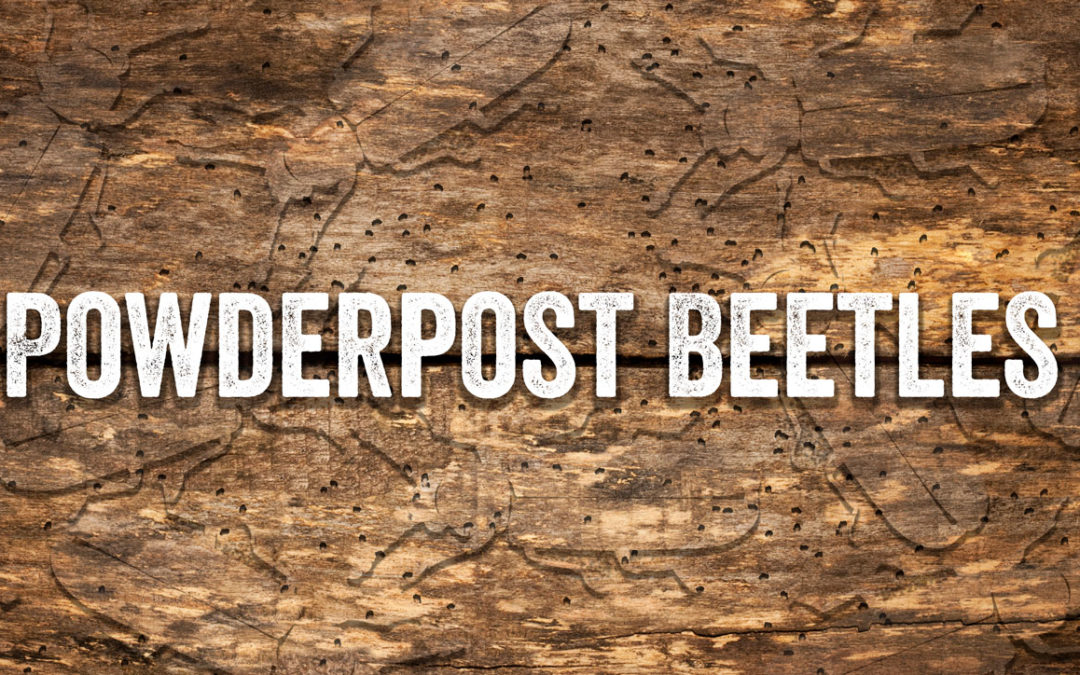“If all mankind were to disappear, the world would regenerate back to the rich state of equilibrium that existed ten thousand years ago. If insects were to vanish, the environment would collapse into chaos.”
E. O. Wilson
If you’ve never heard of powderpost beetles, you are not alone. Moreover, you probably have no idea the amount of chaos these little buggers can cause. Second only to termites in terms of ability to damage wood, these tiny, destructive pests can do a lot of damage to your home. Infestations cause millions of dollars to homeowners every year in repairs and treatment, so guarding against potential damage will help save your home, and your pocketbook, for years to come.
What are powderpost beetles and what do they look like?
Powderpost beetles are one of a variety of wood-boring beetles that can wreak havoc on your home. While there are several species of powderpost beetle, typically, adults are small (generally less than ¼ inch long), often a reddish-brown to black in color, and very slender. However, it is far more likely to find the damage left behind than the actual beetle.
Adult female powderpost beetles lay eggs in the tiny pores of unfinished hardwood. When the eggs hatch, the newborn larvae feed on the sugar, starch, and protein in wood, creating a series of tunnels as they burrow their way to the surface as they approach adulthood. The adult beetle emerges leaving behind small exit hole and a collection of “frass” or flour-like powder which is a combination of wood powder and the beetle’s excrement.
The newly emerged adults then mate, lay new eggs and begin the process anew.
“I don’t care how small or big they are, insects freak me out.”
Alexander Wang
How do I prevent damage from powderpost beetles?
So, how do you keep these repulsive little vermin from causing damage to your home and furniture? Here are some suggestions that any homeowner should keep top of mind:
- If you are building a new home, make sure your builder provides a warranty against bug infestation, at least for the first several years of your home’s life.
- Use new lumber for any construction project. If you use old lumber, you risk bringing powderpost beetles into your home by way of infested wood.
- Make sure any wood you use has been dried and stored correctly. Keep wood moisture levels below 10% by using 4-6 ml of polyethylene on the soil under pier and beam structures.
- Sand, seal, and varnish wood whenever possible as treated woods are not as attractive to these pests as they can’t as easily locate a crack or crevice in the wood in order to deposit their eggs.
- Treat unfinished wood with Boracare and Timbor which will prevent newly hatched larvae from entering the wood.
- Ensure proper ventilation in damp areas including proper airflow (both in and out) to carry away moisture.
- Inspect older furniture every six months or so for exit holes (caused by the beetles as they tunnel through).
- If you identify a hole or tunnel, be sure to mark or seal the holes and vacuum up any powder or debris (infestations will often be marked by a speck of dust that looks like that of fresh-cut wood). Recheck the wood for new holes every few months thereafter.
How long do powderpost beetles live?
Powderpost beetles can have a long life-span as their larvae can take five years before turning into a mature adult. As larvae development and feeding occurs below the wood’s surface, the only way to know if you have a problem is through inspection. If you believe that you have a severe infestation, you may need to consult your local, professional exterminator or fumigator. Make sure that any professional that you use is properly licensed for fumigation.
For additional information concerning your floors, please visit our frequently asked questions. You can also request 3 free samples of any of our flooring products, find local retailers, or contact our team of flooring experts to answer your lingering questions.


